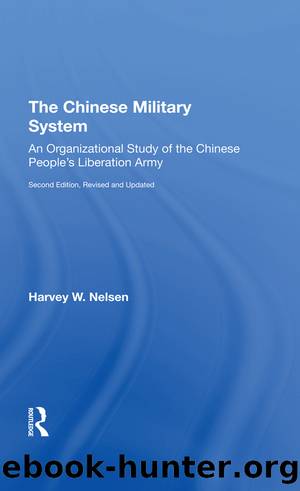The Chinese Military System: An Organizational Study of the Chinese People's Liberation Army--Second Edition, Revised and Updated by Harvey W Nelsen

Author:Harvey W Nelsen [Nelsen, Harvey W]
Language: eng
Format: epub
Tags: Political Science, General
ISBN: 9781000315417
Google: YgiiDwAAQBAJ
Goodreads: 49789815
Publisher: Routledge
Published: 2019-07-11T00:00:00+00:00
5
Military Life
A Civic Action Army?
The official Chinese media projects an image of the soldiery selflessly serving the people whenever not actively engaged in military training; millions of words have been devoted to the subject of soldiers assisting sowing, harvesting, capital construction, and industrial production. This represents a long-standing revolutionary ideal of Mao Tsetung. In 1949, following the successful conclusion of the civil war, he stated that the PLA should be converted into a work force and great training school for cadres.1 Although the military has served as a training ground for Party officials, it has never been a significant work force in support of the civilian economy. According to calculations by Bernhard Grossman, the military contribution to civilian agriculture has never exceeded five hundredths of one percent (0.05%).2 Moreover, there has been no serious attempt to use the PLA as a labor force. By far the highest level of PLA work days in the civilian sector was in 1960, when the nation was suffering severely from economic failures of the Great Leap Forward combined with drought. The PLA devoted over 40 million man-days to civilian workâmostly disaster relief. However, impressive as that figure may sound, it amounted to only 4.6 percent of the total available man-hours.3 Under Lin Piaoâs leadership the PLAâs contribution as a work force declined steadily, despite the fact that Lin had a highly political approach to the PLA as opposed to the âbourgeois military lineâ which argues that soldiers should spend their time soldiering.4 Since Linâs demise, the situation seems little changed: PLA personnel do token farm work in the civilian sector and contribute somewhat more to various capital construction programs. Medical and veterinary troops use their expertise to teach veterinary skills, train some of the paramedical âbarefoot doctors,â and assist communes in the care of domestic animals.5 Even though the Cultural Revolution absorbed billions of PLA man-days in the civilian sector, in that instance the military was serving as a surrogate political control mechanism, rather than as a productive work force.
Instead of directly supporting the civilian economy, the PLA has attempted to become as self-sufficient as possible, running its own farms on its own lands and establishing many small-scale industrial plants, machine shops, and the like to support its technical and maintenance needs. In general, units are assigned on a rotating basis to training and soldiering, agricultural production, and construction/industrial production.6 It is not uncommon for a peasant youth to be inducted into the PLA only to spend a year or so of his three years of active duty slopping hogs on a PLA farm. Company-size units within the Canton Military Region average thirty pigs each. Naturally, the main force infantry corps spend less time in such pursuits than do the regional forces, but all participate to some degree.
While these production efforts by no means meet all the needs of the PLA, they make it, man for man, one of the least expensive standing armies in the world. But this does not explain why Peking
Download
This site does not store any files on its server. We only index and link to content provided by other sites. Please contact the content providers to delete copyright contents if any and email us, we'll remove relevant links or contents immediately.
| Automotive | Engineering |
| Transportation |
Machine Learning at Scale with H2O by Gregory Keys | David Whiting(3955)
Never by Ken Follett(3701)
Urban Outlaw by Magnus Walker(3302)
OPNsense Beginner to Professional by Julio Cesar Bueno de Camargo(3226)
Sapiens and Homo Deus by Yuval Noah Harari(2940)
Will by Will Smith(2732)
A Short History of Nearly Everything by Bryson Bill(2575)
Hooked: A Dark, Contemporary Romance (Never After Series) by Emily McIntire(2461)
Rationality by Steven Pinker(2225)
Borders by unknow(2143)
Holy Bible (NIV) by Zondervan(2054)
The Becoming by Nora Roberts(2026)
The One Percenter Encyclopedia by Bill Hayes(1752)
Freedom by Sonny Barger(1741)
HBR's 10 Must Reads 2022 by Harvard Business Review(1736)
A Short History of War by Jeremy Black(1723)
Five Ways to Fall by K.A. Tucker(1665)
Girls Auto Clinic Glove Box Guide by Patrice Banks(1653)
Go Tell the Bees That I Am Gone by Diana Gabaldon(1643)
